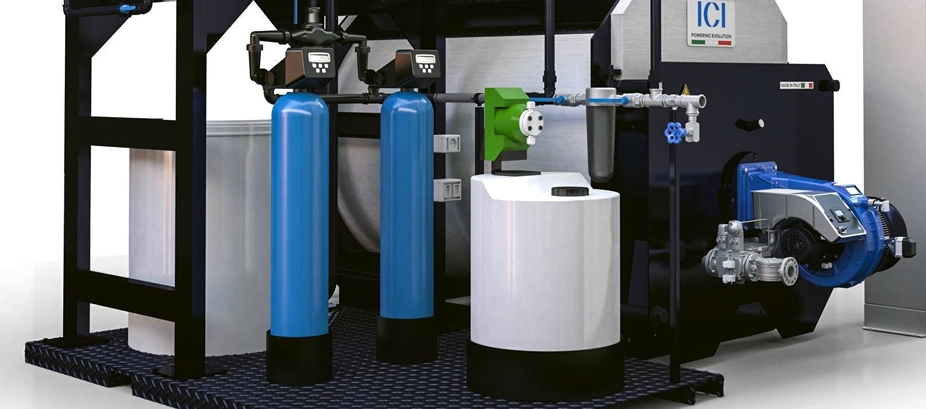Why does water have to be treated before it enters the boiler?
Because water for boilers is a bit like blood for us.
It flows through our bodies and, if we do not keep it filtered and monitored, it can cause blockages and compromise our own health.
In the same way, the water that flows through every boiler must also first be treated and cleaned of impurities.
These impurities generally fall into 2 categories:
- All salts dissolved in water that can fall to the bottom, forming sludge or, worse still, be deposited on hot surfaces in the form of limescale;
- Corrosive agents present include oxygen and other substances that alter the acidity value (pH).
The elimination of salts and oxygen combined with acidity control allow our boiler to function properly over time, without compromising its performance.
Index:
- How should boiler water be treated?
- What kind of water treatment system to choose?
- Example costs for a water treatment system
2. How should boiler water be treated?
Now that we have seen why water needs to be treated, let’s move on to how it is treated and what kind of systems are commercially available.
The drinking water, or more simply fresh water, that we use every day contains, depending on the area, dissolved mineral salts, including a more or less high concentration of calcium carbonate and magnesium.
While the limescale that forms in our kitchens is then easily cleaned, that which forms in boilers is much harder and more difficult to remove.
The limescale fouling that can form on internal walls significantly reduce the heat exchange between hot flue gases and water, leading to an increase in the temperature of the steel plates inside the generator.
This phenomenon can be quickly diagnosed by analysing the temperature of the flue gases leaving the chimney.

Flue gas may have a higher temperature if boiler fouling is present.
The water must therefore be continuously treated to prevent the build-up of limescale or other salts.
There are 2 treatments available for industrial boilers:
- Treatment with reverse osmosis
- Treatment with resins
The essential difference between the two treatments is thatreverse osmosis micro-filters the water, leaving it pure,while the one using resins facilitates a chemical reaction of ion exchange between the salt and the resins, replacing calcium ions with sodium ions.The sodium carbonates are not encrusting and over time settle to the bottom as easily evacuated sludge.
Common fresh water found in aqueducts or groundwater has a pH of 7, making it neutral to our contact.
This pH level, on the other hand, is detrimental to boilers that have steel inner walls that are susceptible to corrosion.
To overcome this problem, all treatment systems include a small pump that dissolves alkalising chemicals in the water to bring the pH value of the water in the boiler to between 9 and 11 as required by all international standards.
It is then necessary to use substances capable of sequestering the oxygen present in the water (reducing agents) and others capable of forming a protective film on the inner walls of the boiler (aliphatic polyamines).
2. What kind of water treatment system to choose?
As we have seen, the most common systems you can choose from are reverse osmosis or systems using resins.
How do you choose between the two?
What kind of economic and utilisation advantages are there?
On the one hand, the resin system has very low initial costs but very high operational costs; on the other hand, the osmosis system has high initial costs and very low operational costs.
Let’s look at why.
Let’s start with the simplest systems, or rather those using resins.
These are in fact composed of mechanically simple components that are easily available on the market. As a result, they require lower initial purchase and installation costs.
Reverse osmosis systems, on the other hand, are more modern and sophisticated and require the use of very expensive membranes for water micro-filtration. This leads to an increase in purchase costs that can be up to 5-10 times higher than for those with resins.
As we mentioned earlier, however, these two types of treatment also differ greatly in their operating costs.
In fact, while reverse osmosis systems micro-filter the water, leaving it clean of all salt or impurities, resin systems only perform ionic replacement without reducing the concentration of salts.
So, on the one hand, we therefore have pure water obtained from the osmotic process that can flow freely inside our boiler without any need for continuous purging to control salinity and violent periodic purging to remove sludge at the bottom with almost no energy costs.
On the other hand, there is salt water resulting from the treatment of the resins, which instead requires additional measures and manoeuvres to keep the boiler in good condition. A steam boiler can in fact be seen as a concentrator of salts that must be periodically removed.
The resin deposit must be continuously purged, with special valves opening to the outside and resulting in a loss of hot water of up to 10 litres per purge which, depending on the system, is carried out every 30 minutes.
Continuing to feed the boiler with salt water tends to increase the salt concentration level, making a second vent to the outside necessary.
To recap, while the reverse osmosis system does not have high additional costs in terms of the chemicals needed for its operation and does not require purging, the resin system requires the continuous supply of raw materials (water for regeneration of the resins and sodium chloride), but also requires continuous purging of hot and treated water.
3. Example costs for a water treatment system
Estimating the cost of a water treatment system can be complicated; there are several parameters and outside conditions to take into account.
The first factors to consider, for example, are all the physical-chemical constants of the incoming water. Starting with hardness and conductivity, which influence the amount of salts required to soften the water.
To simplify, however, let us take a water with a hardness of 25°Fr and conductivity of 350 µS/cm as an example.
We have then hypothesised using a steam generator with a steam output of 3 tonnes/hour and an operating pressure of 10 bar, considering a production cycle of 4 hours per day for 235 days per year.
A final factor influencing costs is condensate return. That is, the percentage of hot water that is recovered after being purged.
The two cases on which we have calculated the costs of the systems are those with 0% and 80% condensate return.
a. Example with 80% condensate return
System with Resins
Annual water purge (4 hours of operation and 235 days per year): ~122 m3/year at a temperature of approximately 185 degrees centigrade
System cost: €1100
Electricity cost: negligible
Water cost: negligible
Salt cost: 2.5 kg per 12m3
Waste of thermal energy due to purging: ~€1,100/year
Total annual cost: €1,300/year + system depreciation
Reverse Osmosis System
Annual water purge (4 hours of operation and 235 days per year): ~4.7 m3/year at a temperature of approximately 185 degrees centigrade
System cost: €7200
Electricity cost: 1,000 kWh/year
Water cost: 569 m3/year
Salt cost: 2.5 kg per 3m3
Waste of thermal energy due to purging: ~€360/year
Total annual cost: €1,050/year + system depreciation

a. Example with 0% condensate return
System with Resins
Annual water purge (4 hours of operation and 235 days per year): ~600 m3/year at a temperature of approximately 185 degrees centigrade
System cost: €1400
Electricity cost: negligible
Water cost: negligible
Salt cost: 7.5 Kg per 12m3
Waste of thermal energy due to purging: ~€5,400/year
Total annual cost: €6,100/year + system depreciation
Reverse Osmosis System
Annual water purge (4 hours of operation and 235 days per year): ~20.7 m3/year at a temperature of approximately 185 degrees centigrade
System cost: €13,500
Electricity cost: 6,200 kWh/year
Water cost: 2,820 m3/year
Salt cost: 7.5 Kg per 3m3
Waste of thermal energy due to purging: ~€200/year
Total annual cost: €4,650/year + system depreciation

After analysing these costs, it can easily be deduced that, depending on the percentage of heat recovered from condensates, one system is more advantageous than the other.
The higher the percentage of heat recovered, the more beneficial it will be to use the water treatment system that uses resins.. Using resins, in fact, the initial costs are much lower, as are the management costs, compared to reverse osmosis.
On the contrary, if it is not possible to recover heat from condensates, it is better to use reverse osmosis systems. These systems are often used when steam comes into direct contact with food or pharmaceutical products, where precisely no heat recovery is possible.

